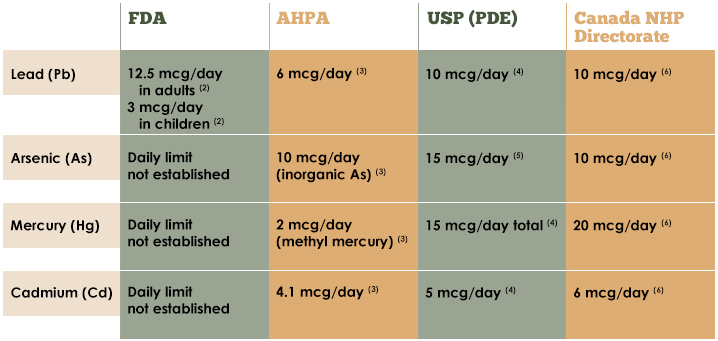Heavy Metal bands - love or hate them - at least we understand them. On the other hand, a metal of relatively high density when compared to water, yeah, that gets a little more confusing. To try to provide some more information and resources on the heavy metals you might find in the soil, water and food, we have put together this collection of commonly asked questions, paired with answers, backed by references if you want to dig even deeper.
Is It Possible to Totally Avoid All Exposure to Heavy Metals?
Unfortunately, no. As WebMD states “Heavy metals, like arsenic, lead, mercury, and others, are all around us. They’re in the ground we walk on, in the water we drink, and in the products we use every day. But high levels of most heavy metals can cause health problems.”(1)
While totally eliminating exposure to heavy metals is not possible, we can make efforts to limit the heavy metals we get in our diet.
So What Are Considered High Levels of Heavy Metals?
There is no single answer to this question. Different agencies and organizations have come to varying conclusions on how much of each heavy metal is considered acceptable to consume on a daily basis.
In addition, different population of people will have different levels of heavy metals that could cause issues. For example, infants and children would want to consume lower amounts of heavy metals than adults.
For these reasons, each person should do their own research and consult with their health care provider to determine what limits they want to apply to their heavy metal consumption.
To help provide a general idea, here is some guidance from a few different agencies…

FDA = Food and Drug Administration
AHPA = American Herbal Products Association
USP = United States Pharmacopeia
PDE = permitted daily exposure
NHP = Natural Health Products
mcg = micrograms
1 Microgram = 1/1,000,000 of a gram – yep, 1 millionth of a gram – so we are talking very small numbers.
Again, we highly encourage you to do your own research to determine heavy metal levels that you are comfortable with. The links in our reference section should help you get started.
Can You Give Me Some Idea of Lead Levels in Foods?
Sure! There is a lot of talk about lead levels in foods, so it can be helpful to see some testing of common foods, so you have a point of reference when looking at lab testing.
Obviously, levels will vary greatly based on where the food is grown, how it is grown and the manner in which it is processed.
One of the best primary sources we have found for looking at lead levels in food is The US FDA Total Diet Study (2006-2013). The FDA samples a wide variety of foods over years and reports on, among other things, heavy metal levels in their testing.
To give you a point of reference, below we show a variety of foods from the FDA Total Diet Study (7) and both their average and maximum lead levels that were observed in the study, as calculated for a serving.
| Average Lead Levels | Maximum Lead Levels | ||
 Fruit Cocktail, | 2.34 mcg | 5.85 mcg | |
 Pineapple, | .854 mcg | 5.61 mcg | |

| .77 mcg | 15.3 mcg | |

| 1.03 mcg | 4.26 mcg | |
 Baby Food, | .91 mcg | 2.38 mcg | |
 Milk Chocolate Bar | .66 mcg | 1.62 mcg |
The above is just a very small sample of foods from the FDA Total Diet Study but it does show that trace amounts of lead are found in many foods and also the average and maximum level can vary greatly.
What If I Eat Organic, Can I Avoid All Heavy Metals?
While organic food has numerous benefits and is free of pesticides and other chemicals, it can still contain heavy metals. Remember, heavy metals are in the soil and water, so even something grown in an organic manner can still contain heavy metals.
What Testing Do You Do For Heavy Metals?
We require all of our ingredient suppliers to provide lab assays showing that they meet or exceed any established federal guidelines for heavy metals. In addition, throughout the year we do spot testing of our finished products.
Can You Tell Me What Heavy Metals You Test For?
Sure, when doing our spot testing we are looking at levels of four heavy metals…
Lead, Arsenic, Cadmium, Mercury
Since 2022 we have been doing increased spot testing for lead.
For The Same Product, Why Does One Test Show Higher/Lower Levels Than A Previous Test?
As you look at heavy metal lab testing results for any specific product, you will notice that the levels vary slightly from test to test.
All of our products are all natural and as with any natural product, there will be a slight variance in nutrients, polyphenols, flavonoids and heavy metals from batch to batch.
We provide consumers with multiple lab test results to provide an indicator of how previous batches have tested, these are not intended to show the exact levels of the specific batch you will receive.
What If I Still Have Questions?
Reach out and let’s chat!
- https://www.webmd.com/a-to-z-guides/what-is-heavy-metal-poisoning
- While The U.S. Food and Drug Administration (FDA) has not established regulatory limits for heavy metals in finished food products other than bottled water, they do set the current IRL (Interim Reference Level) at 3 micrograms (mcg) per day for children and 12.5 mcg per day for adults from food products. https://www.fda.gov/food/metals-and-your-food/lead-food-foodwares-and-dietary-supplements
- AHPA: (American Herbal Products Association) - https://www.ahpa.org/Portals/0/PDFs/Policies/Guidance-Policies/AHPA_Heavy_Metals_Guidance.pdf
- USP (United States Pharmocopoea) - https://tools.thermofisher.com/content/sfs/brochures/WP-71654-ICP-MS-Trace-Elemental-Contaminants-Dietary-Supplements-WP71654-EN.pdf
- https://chemicalsolutionsltd.com/regulations/usp-2232/
- https://www.canada.ca/en/health-canada/services/drugs-health-products/natural-non-prescription/legislation-guidelines/guidance-documents/quality-guide.html
- FDA Total Diet Study- https://www.fda.gov/media/77948/download











